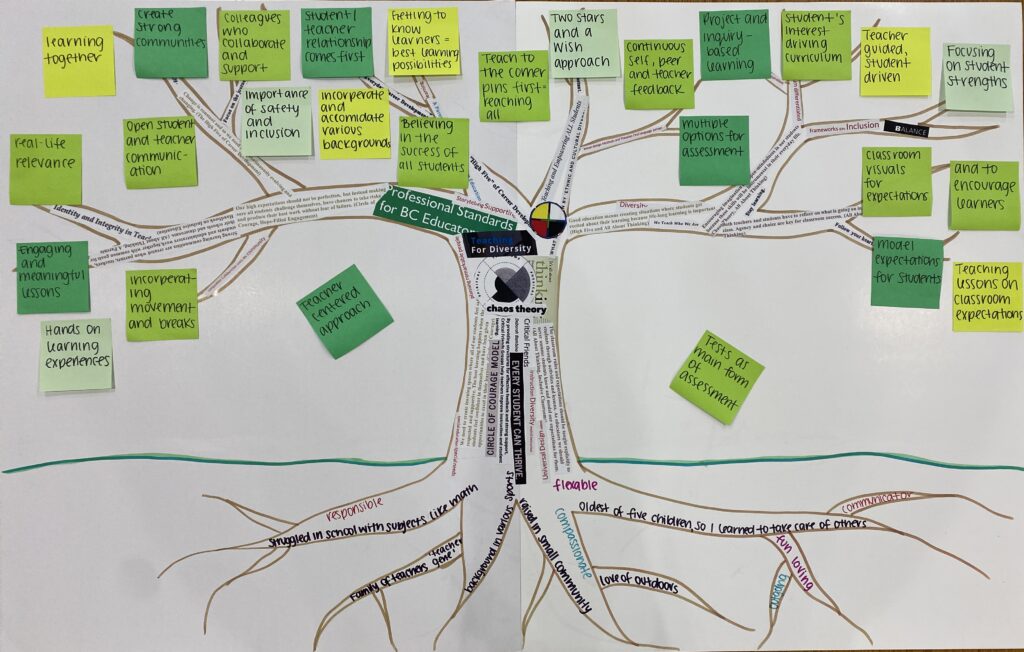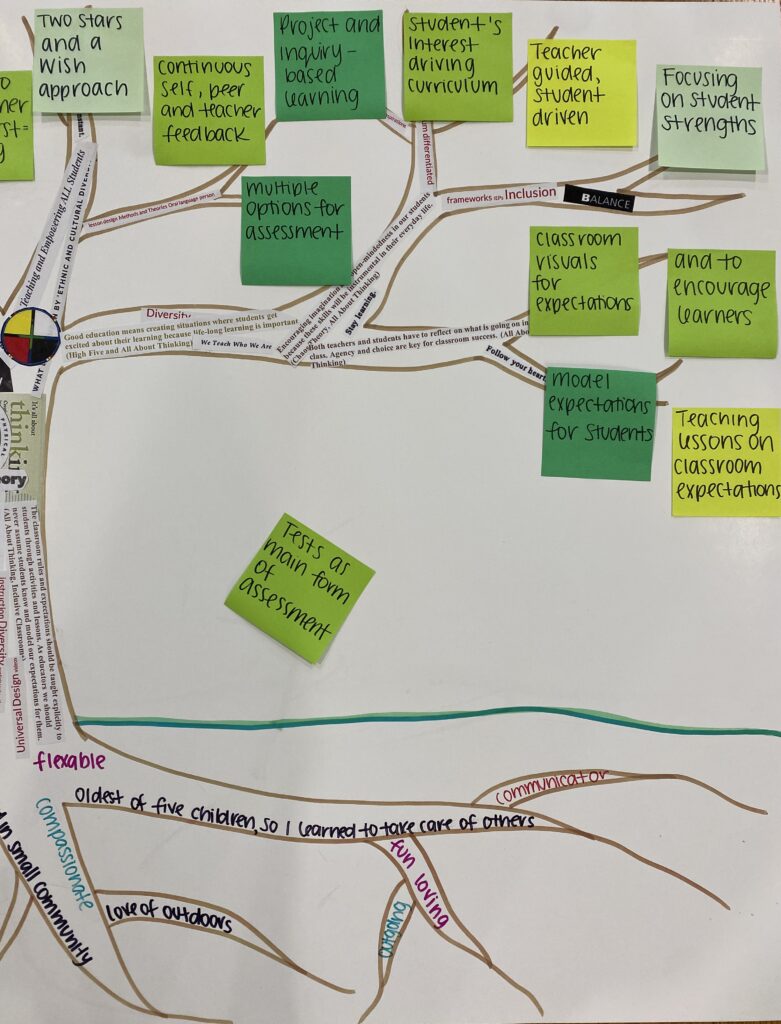To end this summer semester, we were asked to create a capstone project: a model or metaphor for the learning that we had accomplished throughout the last six weeks. This project was meant to not only demonstrate our learning, but also capture who we are as future educators. For this assignment, I chose to make a tree representing me, and where the knowledge I have gained is taking me.

In this picture you see above, the roots represent me, some vital pieces of my history that led me to teaching and some qualities that I possess that will be crucial to my career as an educator. The trunk and branches of the tree are articles, books and other resources that we have read over the past six weeks that have become crucial to my own teaching practice and pedagogy. In this section there are also excerpts I have written myself of key aspects of our course readings that were important to me. Finally, there is the leaves on the tree. Here is where I put the concepts and approaches that these readings made me want to implement in my future practice. As you can see there are also a few fallen leaves. These leaves represent concepts that were important to me at the time I entered the program, but throughout my educational journey, I have realized are no longer approaches I desire for my future classroom.
As I head into the final block of this program, I am amazed by all the growth I have done in the past year. So much of the learning I have done in this block and past blocks has truly shaped who I want to be as an educator. To me, this project exemplifies that. There are a few things that I always knew would be important to me as an educator, such as believing in the success of all students, importance of safety and inclusion, and creating meaningful and engaging learning. There are also some concepts that snuck up on me, like the importance of relationships and placing value on formative or ongoing feedback that I didn’t know just how crucial I would find them to my practice.

Getting closer and closer to becoming a teacher means that I often dream of what my future classroom might look like. My future aspirations are what is written on all these leaves. In these dreams of mine, I think of a classroom where my students and I co-create rules and criteria together. My classroom has both motivational posters and helpful learning guides posted on the walls beside valued student work on display. In this classroom there is an open line of communication between my students and I, where they feel comfortable approaching me whenever they need it. These students have a say in where the curriculum takes us and often their inquiries are what fuels our learning. All my students feel loved, valued, and respected in my classroom regardless of their various backgrounds.

My lessons are fun and engaging for the students. Whenever possible I incorporate real-life relevance for the students so they can see where each lesson, unit or concept could take them in their future endeavors. I am able to look at my student’s assignments and provide them with positive and constructive feedback that each student can use. My students could take pride and ownership of their work and are constantly growing and succeeding. I would know my students well enough that when assessments come around, I can look at their work and know it reflects the learner. My students would trust that I would only give them summative assessments that would demonstrate their vast knowledge and the term ‘summative assessment’ wouldn’t scare them. These are some of the dreams and aspirations I have for my future classroom.
Now as I have continued to evolve these goals for my future classroom, there are a few concepts that I have realized don’t fit within my teaching approach anymore. These are the fallen leaves. One of them reads: a teacher centered approach. Coming into this program I thought that in order for my students to be successful, I had to be in total control of my classroom, that the students would sit and listen to me during lessons or activities. But then I realized that this wasn’t even successful for me in my own learning. I learned best from group discussions and my peer’s various perspectives. As I have reflected on my classroom aspirations, I have realized that a student-centered approach was what I was aiming for all along.
I also have moved away from this second ‘fallen leaf’ which states that tests are a main form of assessment. Even though I didn’t do well on big tests in school, I thought that they were a necessity. I now realize that I don’t remember a lot of what I needed to know for my exams, I studied and then once I took the test, then I just let that information go. I just learned to regurgitate the information then forget it. Now, I have learned the importance of formative and ongoing feedback. Summarize assessment should show how successful formative assessment has been for each student. I believe we shouldn’t do our summative assessments if we know our students aren’t ready. In theory, we should also be able to look at our summative assessments and say, “you know, this wasn’t Brivee’s best work, maybe we should look at this again”. If learning is a continuum then we need to implement that in our practices as well.
As I look back on this project, I see that I now know what I want my future classroom and practices to look like, now I just need to future out the how to implement it. These are my goals and now I need to continuously learn how I can do this all to make the best learning environment I can. A lot of these resources that I have included in my capstone project provide me with a good starting point, with tips and examples. Good thing learning is life-long, because I am going to need it, and I am going to love it.